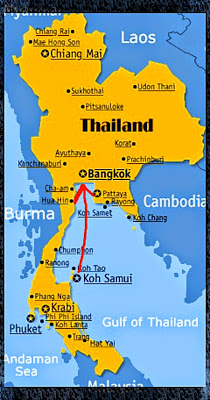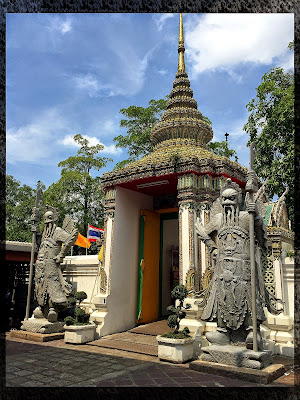From Koh Samui, the ship sailed north/northwest past the coast of mainland Thailand. In the early morning hours on Friday, October 31st, we boarded a local pilot who guided us safely into our berth in the port of Laem Chabang which was located in the Gulf of Thailand. After a custom's inspection the ship was released by authorities and passengers were allowed to go ashore around 7:15 a.m. The day that greeted us was partly cloudy with temperatures hovering in the mid 80F (29C).



We had a ten hour tour booked, which began around 7:30 a.m., planned for the day Our tour bus was ready and waiting for us at the port. Bangkok was our destination and it was a full day of exploration that would not get us back to the ship until after 6:00 p.m. that evening.
To begin with, LOVED the neon, day glow colors inside our bus. It was like a rolling disco on four wheels. Great way to wake up and start our day.


Since 1932, the Head of Government in Thailand has been the Prime Minister. On May 7, 2014, Thailand's first female Prime Minister was ousted from office on charges of abuse of power. There is also a royal family in Thailand (formerly known as Siam) that has dated back to 1238. This exotic and enchanting monarchy has generated a novel (Anna and the King of Siam) and a movie (The King and I) which showcased riches and splendor in a world untouched by modern society. Until five months before our visit, Thailand had the world's longest reigning current monarch (Bhumibol Adulyadej) dating back to June,1946. On May 22, 2014, a military coup, led by Army General Prayuth Chan-ocha, took place and they seized power. At the time of our visit, Thailand was in a political mess. Curfews were in force from 10:00 p.m. - 5:00 a.m. local time, broadcast media was suspended and gatherings of more than five people were banned. Our tour guide informed us that just speaking against the current militia was cause for arrest. Note to self: our problems are small compared to so many others. This is what travel teaches - perspective.
Don't let the problems in their government steer you away from Thailand. There is so much to see and do and it can't be described in one visit. Thailand is an angel and the devil sitting on any visitor's shoulders simultaneously. On one side, it is magnificent golden temples and palaces, spirit houses, saffron-robed monks, smiling people, colorful tuk tuks, exotic vendors, glamorous resorts, gems and silks, world renowned cuisine and a culture that is real and not synthetic. The other shoulder offers the world's most congested streets, naughty nightlife (so I'm told), intense heat and pollution from cars and industry (we witnessed the grey smog that hung over Bangkok - below).

Thailand started out looking like just another big city with highways except the street signs were in Thai, obviously.




But, then it began to slowly morph. The skyline became dotted with color, landscaping went green and architecture became unique. In the distance was the Rama IX Bridge, its yellow spans stretching over the Chao Phraya River.

On the top of the State Tower building, the second tallest building in Thailand, sat a gold dome. This was home to the world famous and award winning Sirocco Restaurant and Sky Bar, serving Mediterranean cuisine al fresco and offering a 270 degree panorama view of Bangkok and the Chao Phraya River.





The fabulous pink elephant round-a-bout outside the palace was created in 2011 to celebrate the 84th birthday of King Bhumibol Adulyadej. Elephants are a sacred symbol of of royal power.

I was getting tuk tuk fever! In case you didn't know, tuk tuks (Sum Lahs) are three wheeled vehicles (also known as "auto rickshaws") used commonly in many countries around the world. I love them! Especially the ones decked out in personal style and lots of color.





Our next stop was the Royal Pavilion Mahajetsadabadin, built in 1989 and used as a reception area for the King (or Rama) to greet Royal visitors. This area is pedestrian only traffic with perfectly manicured grounds and a nice walk. Very stunning and opulent.










Our first monk sighting, an integral part of Thailand. Every Thai Buddhist man must leave their family and go through the stage of being a monk for a few weeks, years and sometimes a lifetime. At ages 7-19, they are called "novice" and 20 years and older are called "monk".





The bottom of Buddha's feet were inlaid with mother of pearl.































Around the main temple are walls on four sides. Along those walls were more than 150 Buddha statues in various stages of repair. In 2007, a project began to re-gild each of the statues.


This was the view standing just outside the top of the steps of the main temple and looking towards the surrounding walls.




The humidity and heat combined forces and were delivering a real "punch" by this time. We were wilting from the intense sun and lots of walking and now it was time for some breeze and a cool break. As we exited Wat Suthrat, a row of tuk tuks were lined up and waiting for us. The next part of our tour was a ride around the inner part of Bangkok. Yippee!!

Can you tell I like lime green? Yup! I chose the most colorful tuk tuk I saw.



And away we went!






Tributes to Queen Sirikit from her recent birthday on August 12th.



We "tuk-tukked" over to a charming boutique hotel called the Royal Princess Larn Luang Bangkok and had a scrumptious buffet lunch in their Princess Cafe. I tried rice dumplings in coconut cream (Pa Grimp Kai Tuew), Thai dessert candies (Luk Chup) and green beans ground in coconut milk and sugar and steamed in a tied banana leaf. For items I could not identify, I followed some waiters around and asked them questions while trying to take notes, but it was a hopeless cause. Not that they weren't helpful...they were. We just had a language barrier and experienced a "loss in translation".




This was the end of our day and it had been a full one. Our tuk tuk driver drove us back to our waiting tour bus. From there, we headed back to the port. On the ride back, I learned some very interesting facts: Buddhists must be cremated when they die; Buddhists believe in Karma and that good begets good; monks are the "psychologists" of the Buddhists and help them solve problems according to their religion; Thai families have many children due to their history as farmers; main crops are rice, tapioca, fruits and veggies; Thailand means "Land of Freedom"; tap water needs to be boiled before drinking; Thailand has big problems with termites.
Thailand deserves another visit if I am ever in the area again. I felt safe when I explored on my own in Bangkok, despite its volatile politics. I can't say the same for other countries I have visited during such turmoil. It must be the people and the way they embrace respect, religion and tradition in such a harmonious way.
Click here to see what happened next on our journey: Asia and Australia 2014

No comments:
Post a Comment